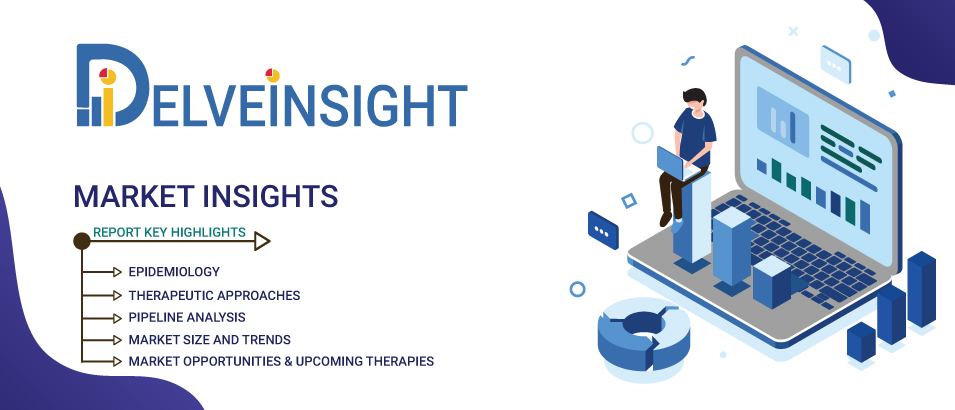Post-Traumatic Stress Disorder Market: Analysis of Epidemiology, Pipeline Therapies, and Key Companies Working in the market
DelveInsight’s Post-Traumatic Stress Disorder (PTSD) – Market Insights, Epidemiology, and Market Forecast-2032 report deliver an in-depth understanding of the Post-Traumatic Stress Disorder (PTSD), historical and forecasted epidemiology as well as the Post-Traumatic Stress Disorder (PTSD) market trends in the United States, EU5 (Germany, Spain, Italy, France, and United Kingdom) and Japan.
The Post-Traumatic Stress Disorder (PTSD) market report provides current treatment practices, emerging drugs, Post-Traumatic Stress Disorder (PTSD) market share of the individual therapies, current and forecasted Post-Traumatic Stress Disorder (PTSD) market Size from 2019 to 2032 segmented by seven major markets. The Report also covers current Post-Traumatic Stress Disorder (PTSD) treatment practice/algorithm, market drivers, market barriers, and unmet medical needs to curate the best of the opportunities and assesses the underlying potential of the market.
Some of the key facts of the Post-Traumatic Stress Disorder Market:
- Participants with lifetime PTSD have higher rates of psychopathology (including major depressive episodes, conduct disorder, and alcohol dependence), risk events for self-harm, for suicide attempts, violent offenses, and functional impairment. It is necessary to characterize comprehensively the prevalence, clinical features, and risk factors associated with trauma exposure and subsequent post-traumatic stress disorder (PTSD) in young people.
- Trauma exposure and PTSD in young people are prevalent: 15–82·5% of young people experience traumatic events and 1·3–8·1% experience PTSD in their lifetime. with estimates varying accordingly. However, these estimates are largely obtained from studies undertaken in the USA with now-obsolete diagnostic criteria (DSM-III and DSM-IV) (Lewis et al., 2019).
Got queries? Click here to know more about the Post-Traumatic Stress Disorder Market Landscape
Post-Traumatic Stress Disorder Overview
Post-Traumatic Stress Disorder (PTSD) is a chronic psychiatric disorder that may occur in people who have experienced or witnessed a traumatic event such as a natural disaster, a serious accident, a terrorist act, war/combat, or rape or who have been threatened with death, sexual violence or serious injury. PTSD can occur in all people, of any ethnicity, nationality or culture, and at any age. People with PTSD have intense, disturbing thoughts and feelings related to their experience that last long after the traumatic event has ended. They may relive the event through flashbacks or nightmares; they may feel sadness, fear or anger; and they may feel detached or estranged from other people.
PTSD is treated via a combination of psychotherapy and pharmacotherapy. Pharmacotherapy is considered a first-line treatment with the use of selective serotonin reuptake inhibitors and serotonin-norepinephrine reuptake inhibitors. A number of psychological treatments or psychotherapy for PTSD exist, including trauma-focused interventions and non-trauma-focused interventions. Trauma-focused treatments include Prolonged Exposure (PE) and Cognitive Processing Therapy (CPT) and Non-trauma-focused treatments include relaxation, stress inoculation training (SIT), and interpersonal therapy.
Post-Traumatic Stress Disorder Epidemiology Insights
- Trauma exposure and PTSD in young people are prevalent: 15–82·5% of young people experience traumatic events and 1·3–8·1% experience PTSD in their lifetime. with estimates varying accordingly. However, these estimates are largely obtained from studies undertaken in the USA with now-obsolete diagnostic criteria (DSM-III and DSM-IV) (Lewis et al., 2019).
- A single-site study by the American Psychiatric Association from the U.S. found that 11.9% of emergency medicine (EM) residents met the criteria for PTSD, with 30% having symptoms that did not meet the threshold for diagnosis. A study of emergency physician EPs and advanced practice providers from a group practice in the U.S. found a PTSD prevalence of 12.7%.
- In a recent publication by Spottswood et al. (2017), the National Comorbidity Survey Replication (NCS-R), one of the largest epidemiological studies of mental disorders performed in the United States general population, the lifetime prevalence of PTSD in adults is 6.8% and the annual prevalence is 3.5%.
Post-Traumatic Stress Disorder Epidemiology Segmentation
- Total Post-Traumatic Stress Disorder prevalent cases
- Total Post-Traumatic Stress Disorder gender-specific cases
- Total Post-Traumatic Stress Disorder microbiology-specific cases
- TotalPost-Traumatic Stress Disorder age-specific cases
Post-Traumatic Stress Disorder Market Outlook
The Post-Traumatic Stress Disorder (PTSD) market outlook of the report helps to build a detailed comprehension of the historic, current, and forecasted Post-Traumatic Stress Disorder (PTSD) market trends by analyzing the impact of current therapies on the market, unmet needs, drivers, and barriers and demand of better technology. This segment gives a thorough detail of the Post-Traumatic Stress Disorder (PTSD) market trend of each marketed drug and late-stage pipeline therapy by evaluating their impact based on the annual cost of therapy, inclusion and exclusion criteria, mechanism of action, compliance rate, growing need of the market, increasing patient pool, covered patient segment, expected launch year, competition with other therapies, brand value, their impact on the market and view of the key opinion leaders. The calculated market data are presented with relevant tables and graphs to give a clear view of the market at first sight. According to DelveInsight, the Post-Traumatic Stress Disorder (PTSD) market in 7MM is expected to witness a major change in the study period 2019-2032.
Learn more by requesting for sample @ Post-Traumatic Stress Disorder Market
Post-Traumatic Stress Disorder Key Companies
- Nobilis Therapeutics
- Otsuka Pharma
- Compass Pathways
- And many more
Post-Traumatic Stress Disorder Therapies
- BTX001
- Brexpiprazole
- COMP360
- And many more
Table of Contents
- Key Insights
- Report Introduction
- Executive Summary of Post-Traumatic Stress Disorder
- Disease Background and Overview
- Epidemiology and patient population
- The United States
- EU 5
- Post-Traumatic Stress Disorder Emerging Therapies
- Post-Traumatic Stress Disorder Market Outlook
- Market Access and Reimbursement of Therapies
- Appendix
- Post-Traumatic Stress Disorder Report Methodology
- DelveInsight Capabilities
- Disclaimer
Click here to read more about Post-Traumatic Stress Disorder
Media Contact
Company Name: DelveInsight Business Research
Contact Person: Adya Kaul
Email: Send Email
Phone: +91 9568243403
Address:304 S. Jones Blvd #2432
City: Las Vegas
State: NV
Country: United States
Website: https://www.delveinsight.com/



